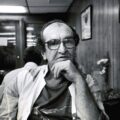These Molten Flowers: on Lola Ridge, radical poet and activist

In a news clip from 1927, Lola Ridge stands alone in the middle of a street as thousands of people demonstrate against the execution of Sacco and Vanzetti. The crowds pulse around her, “one tall, thin figure of a woman,” as she steps out, alone, “a good distance into the empty square.” Even as the police charge her down, even as their horses’ hooves sound in her ears, “she did not move … she was not to be driven away.”
Like the two Italians whose trial and conviction fomented riots all over the Northeast, Ridge was an anarchist at a time when, as biographer Terese Svoboda writes, “anarchy was a political possibility.” She was a famed iconoclast and peer of such writers, artists, and intellectuals as Mina Loy, James Oppenheimer, Charles Reznikoff, Edna St. Vincent Millay, Louis Zukofsky, Louise Bogan, Man Ray, Sherwood Anderson, and Jean Toomer—many of whom she published as an editor or hosted at her New York City soirées. The New York Times obituary would describe Ridge as one of the “leading poets of America,” and in 2011, former poet laureate Robert Pinsky called her “[a]n early, great chronicler of New York life.” She was a chronicler, too, of the working class throughout the industrial Northeast:
Charge the blast furnace, workman…
Open the valves—
Drive the fires high…
(Night is above the gates)…
…
Charge the converter, workman—
Tired from the long night?
But the earth shall suck up darkness—
The earth that holds so much…
And out of these molten flowers,
Shall shape the heavy fruit…Then open the valves—
Drive the fires high,
Your blossoms nurturing.
(Day is at the gates
And a young wind…)
Few today have heard of Ridge, but her impact on America society cannot be denied. She was that rarest of creature: a poet whose work brought real, tangible change. Ridge’s poem about Sacco and Vanzetti, for instance, was duplicated by the thousands, passed hand-to-hand among activists, and would help free the labor activist Tom Mooney from unjust incarceration.

Anything That Burns You: a Portrait of Lola Ridge, Radical Poet
by Terese Svoboda
Hardcover, $29.95
Schaffner Press, 2016
Anarchism, perhaps, was the inevitable intellectual conclusion for a woman whose life had been steeped in disorder and unaccountability. Born in Dublin in 1873 to parents who soon separated, Ridge was four years old when she and her mother immigrated to Sydney, Australia, where they lived in “a small bare room.” She was not much older when they relocated to a hardscrabble mining camp in the gold fields of New Zealand, near Hokitika, population 5,000. Ridge’s mother married a seaman-turned-prospector and alcoholic, Donald MacFarlane. The family was poor, her step-father haunted by mental illness. Ridge would work to disguise these origins (as well as her true age) but they formed the compass of her entire life. Poetry offered an escape, or a productive method of processing these early difficulties. Though her desire for fame probably drastically inhibited sustained intimate relationships, radical politics did provide her with a community of like-minded writers, and an intellectual scaffold for social and personal transformation.
Among Ridge’s first poems, never published, is a poem inspired by her difficult step-father, as well as bush ballads like “Song of the Sluicers” about the New Zealand gold miners. From the beginning, personal and political found their connection in verse. Her identity as a poet preceded or precluded all others, and sheltered her from the risks of intimacy. Svoboda quotes the writer Kay Boyle on Ridge, “She is made for everyone to worship—and she doesn’t really give herself to or actually need anyone.”
Ridge’s childhood home of Hokitika was home to a radical political tradition, giving the leftist, pro-labor politician Richard Seddon—whose motto was “It is the rich against the poor”—his start, launching a career that would eventually lead to the premiership of New Zealand. Unlike most rural, country people in the age before radio and media, Ridge had a sense of public life and politics from the beginning. And, as Svobda writes,
With such a heady heritage, Ridge’s exposure to these radical measures must have encouraged an innate belief that she could control her own destiny, and that others deserved that power too.
In 1895, at the age of twenty-two, Ridge married and had a child, who would be dead of bronchitis just two weeks later. A long five years after that, she bore another child, Keith, who survived, and in a few years she moved with her son and mother to the nascent bohemia of North Sydney to study painting and music. In 1907, separated from her husband and mourning her mother’s death, Ridge and her eight-year-old son joined the surge of Edwardians setting sail for America; first stop, San Francisco.
Wind rising in the alleys
My spirit lifts in you like a banner
streaming free of hot walls.
Your are full of unspent dreams…
You are laden with beginnings…
There is hope in you . . not sweet…
acrid as blood in the mouth,
come into my tossing dust
Scattering the peace of old deaths,
Wind rising in the alleys,
Carrying stuff of flame.
Ridge might have left her young son with his father’s large, accommodating family back in Hokitika. Instead, she left him at the Boys and Girls Aid Society in Los Angeles. It was not unheard of for professional women, living alone, to put their children into such institutions, and Svoboda later supplies the details on child neglect on hand among Ridge’s literary circle. Keith lived at the Los Angeles Orphan Home Society until he turned fourteen, the age “when all orphans were then turned out into the world,” and then lived briefly with his mother in New Orleans. After that, Ridge apparently never saw her son again.
Earning money by writing for publications like the Overland Monthly, Ridge soon sailed to New York, where she arrived in 1908, claiming to be a U.S. citizen. She took residence “in a five by seven room in an East Side tenement”. Her living arrangements would provide intimate knowledge of life on Hester Street and the sweat shops of the era, material she used for her poem “The Ghetto,” forming the foundation of her breakout 1917 volume of poems by the same title.
Not long after arriving in New York, Ridge met David Lawson, a Glasgow-born electrician and civil engineer twelve years her junior. Lawson became her life-long companion, and later her husband. “He was,” as Svobda writes, “a good foil for Ridge’s flights … Were the gender reversed, his place in her life would be devoted wife, just what any working writer requires.” Ridge herself wrote in the poem “Two”:
He was the hangar
Where ungratefully
She rested after flight
“It hurts me terribly to hurt him,” Ridge wrote in a letter, “but I cannot help it. I’ve a right to live completely, however brief the interval may be—”. It seems Ridge’s idea of “living completely” left little room for monogamy or constancy—or perhaps for genuine intimacy, much less for the sustained relationships with an extended family required for raising a child. Ridge and Lawson would often live apart while Ridge when she later traveled extensively or attended Yaddo or MacDowell artist colonies; Ridge had a significant affair with another man when toward the end of her life, she lived in Mexico, yet all the while Lawson dutifully sent her the support—money, books, a favorite dressing gown, or medications—she would need.
In New York, Ridge also befriended the “most famous anarchist of the century,” Emma Goldman, and worked in Goldman’s office on East 13th Street, supplementing her income—as Walt Whitman had—working as an artist’s model. Quickly earned Goldman’s trust, Ridge began publishing her magazine Mother Earth. Ridge also managed the Ferrer Center, an anarchist organization on St. Mark’s Place. Classes were led by activists, artists, and writers like Edward Markham and John Reed; Will Durant and Jack London frequented the center, which transformed into The Modern School. She became a known figure in the political circles of her time, and she was indeed a part of the political avant garde in many ways. In February 1919, for instance, a decade before Virginia Woolf would publish A Room of One’s Own, Ridge gave a speech in Chicago entitled “Woman and the Creative Will,” which advocated women working toward a “completely new social and economic fabric.”
The New York years, between 1917 and 1928, were an extraordinary time for Ridge, a decade of literary comaraderie, and of writing and publishing modernist poems alongside Wallace Stevens and Marianne Moore in the best magazines––Poetry, Current Opinion, Dial, and Literary Digest, The International, Others, New Republic. Soon B.W. Huebsch, publisher of Portrait of the Artist as a Young Man and Lawrence’s The Rainbow, published Ridge’s manuscript The Ghetto and Other Poems, creating an immediate sensation. Her poems in that volume reflected her innate sense of the continuity between politics and art. The volume was praised in reviews by Conrad Aiken and Hart Crane; Louis Untermeyer called it one of the three great books of the year.
Cool, Inaccessible air
Is floating in velvety blackness shot with steel-blue lights,
But no breath stirs the heat
Leaning its ponderous bulk upon the Ghetto
And most on Hester Street…The heat …
Nosing in the body’s overflow,
Like a beast pressing its great steaming belly close,
Covering all avenues of air…The heat in Hester Street,
heaped like a dray
with the garbage of the world.
Ridge worked tirelessly as associate editor of Others; later she became the American editor of the transcontinental magazine Broom. In 1920, Huebsch published Ridge’s second book, Sun-up ad Other Poems, again to rave reviews in The New York Times, Marianne Moore’s The Dial, and The Nation. Her third book, Firehead—often compared to Robinson Jeffers’s Dear Judas—was another success, and her poems appeared beside those by Eliot, cummings, Moore, and Williams, in the anthology Prize Poems 1913-1929. It’s remarkable that Ridge would find herself praised by, and compared to, such a broad diversity of her contemporary peers. Her work, charged with political urgency, stands apart from her modernist contemporaries. Her independence, of course, lies at the core of her identity as both an artist and activist:
All violence is but the agony
Of caged things fighting blindly for the right
To be and breathe and burn their little hour.
Ultimately, though, Ridge’s extraordinary literary star began to wane; in middle age, she developed health problems, and her dependency on the stimulant Gynergen grew in the years prior to her death in 1941.
“The obligation of the artist,” Svoboda writes, “and especially the artist-celebrity, is to witness and record—like a journalist, yes—but also to express their feelings about what they see.” Ridge was a poet for whom social ideals were if not uppermost then at least always relevant, contrary to the beliefs of the New Critics, of whom Svoboda asks, “Can it be true that poetry does nothing?”
Although poetry has always addressed society’s problems and recorded its cultural and political history—whatever its formal precepts—society has not always wanted to hear about them. What has been lost by these omissions is the radical and political tradition in twentieth-century American poetry, and the idea that such subjects were even appropriate for poetry. An entire generation and tradition of American poetry has essentially been amputated from literary consciousness.
Here Svoboda perhaps overstates her case, neglecting, say, the poet Natasha Trethewey and her confrontation with the racial legacy of her native Deep South in Native Guard (2007) and elsewhere; or the political poems of Carolyn Forche, and indeed her entire anthology Against Forgetting: Twentieth-Century Poetry of Witness (1993); or Diane Gilliam Fisher’s Kettle Bottom (2004), poetry of miners’ hardscrabble and desperate lives in West Virginia—to name three examples pulled more or less at random just now from my shelves.
One thing is certain: the early twentieth-century anarchists’ grasp of the methods of change are not ours; genuine cultural and sociological change may be boosted by demonstrations and, yes, poetry and prose—but it mostly occurs over generations.
Lola Ridge lived in three continents before she was thirty, the child of multiple family dislocations and chemical dependencies, herself troubled by addictions, for whom the ideologies of the times—socialism, anarchism, feminism—allowed and encouraged her to be a part of the mainstream, as all these accommodated (as Victorian or Edwardian mores could not) her own wounds and the limitations imposed by her own upbringing. She lived in poverty at the epicenter of culture, New York City, where she was acquainted with major literary figures of the time. She edited a prestigious magazine and was hosted at the artist’s colonies of the day, published alongside major literary figures—in short, to triumph as a writer. That these circumstances did not also allow or encourage her to understand and accept her own origins, or experience fully her human relationships, is perhaps her greatest tragedy. That so many women across the globe today struggle against all odds as parents, artists, political actors, and human beings—for autonomy, economic independence, expressive freedom, and the integrity of their families—is most certainly ours.
About Zara Raab
Zara Raab's most recent books are Rumpelstiltskin, or What's in a Name? (Finishing Line Press) and Fracas & Asylum (David Robert Books, 2013). She lives in western Massachusetts. Visit her at http://www.zararaab.com.





